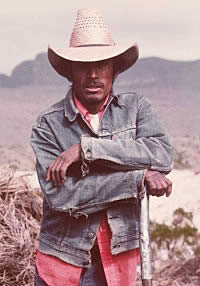
Leaning on his pitchfork, a
worker takes a break from pitching weed into the
vat. While early candelilleros wore khaki clothing,
tire-tread sandals and a handmade hat from Mexico,
today's workers wear blue jeans, imitation leather
shoes and a western hat or baseball cap. Photo
by Raymond Skiles. Click to see full image.
|
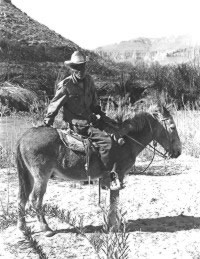
A cerero and his burro relax
for a moment. Some of the workers are family men
who travel back to their villages from time to
time to see their families and get supplies. Photo
by Curtis Tunnell.
|
|
If you are wanting to buy a burro it is always
worth 100 dollars, and if you are wanting to sell
one it is always worth 25 dollars.
|

A wax maker's meal, consisting
of black coffee, beans, and tortillas. At times,
the workers supplement their diet with wild game
and plants, such as hearts of desert lechuguilla
or sotol, which they slow-bake in hot ashes. Photo
by Curtis Tunnell.
|
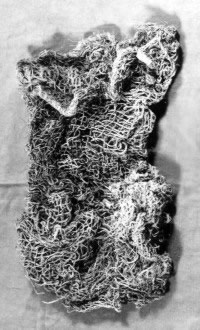
A bag handmade from cordage
twisted from fibers from the desert lechuguilla
plant. Photo by Cutrtis Tunnell.
|
|
I was walking with a wax collector one time
when the candelilla load began to shift on the
burro. The man stepped over to a torre yucca and
stripped off some fibers with his fingernail and
twisted them into a crude cord and tied the candelilla
load to the packsaddle more securely.
|
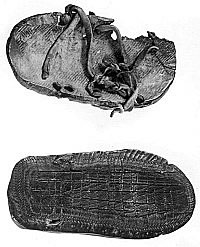
Handmade sandals with soles
made of tire treads. Modern wax makers tend to
wear factory-made shoes. Photo by Curtis Tunnell.
|
|
Wax Makers: Conditions and Wages
Wax makers are called cereros or
candelilleros or occasionally paileros
and are always men. There is a conspicuous absence of
women in the camps. The occupation of wax maker is one
that many men along the border have practiced at one
time or another, and a few men work at the wax vats
for years.
All wax makers come from Mexico. You couldn't
get people in this country to make wax if it was worth
five dollars per pound. You can't just hire anyone to
make wax, they need to have had experience. It is very
hard work and relatively few men can do it well. The
men have to have tough hands and a strong back to pull
candelilla. They never use gloves and you can tell by
looking at their hands if a man has worked with wax
a long time. According to Davis Adams in a 1980 interview,
experienced men can get more wax from each ton of weed
and get more wax with less acid.
Some of the cereros are family men who
travel back to their villages—Las Norias, Boquillas,
Santa Elena, El Mulato—periodically to visit their
families, attend mass, and get supplies. Others are
young men who are wanting to learn a trade, earn sufficient
money to go to a city like Ojinaga or Juarez, or, more
likely, head north as illegal aliens. A few are drifters
or men outside the law and are hostile toward strangers
with cameras or hide in the rocks to avoid such contacts.
Generally cereros work eight to ten hours
per day and six days per week. Sometimes the men will
work for 20 or 30 days straight and then quit and go
to nearby towns "to see the girls and get alcohol."
They also like to observe all manner of religious and
political holidays. Some men may go well down into Mexico
to visit family or attend weddings. Their usual mode
of travel is by burro or "they just walk."
A good wax maker can gather the plants
for, and extract about 1,000 pounds of wax per month
if he works at it. One man can make wax by himself,
doing everything from gathering the plants to the final
boiling and bagging, but usually at least two men work
together. Men of the same family (for example, a man
and his sons or several brothers) often work together
on a crew.' When the price is right the men produce
wax the year round; however, slightly more wax is produced
in winter than in summer.
The men are paid a little more if they
provide their own burros, but a foreman or rancher always
has extra burros on hand. When asked the price of a
burro, one informant said: "If you are wanting
to buy a burro it is always worth $100, and if you are
wanting to sell one it is always worth $25." He
estimated a good average price in 1980 to be about $50.
Adams said wax makers on his ranch will
work hard until they have made $200 or $300 in a month,
then they begin to slack off. If they worked hard all
month they could make as much as $600, but they don't
seem interested in making as much money as possible
each month. He believes that, generally, the standard
of living of the wax makers is much better than it used
to be, and that "some day if Mexico becomes sufficiently
affluent, no one will want to produce candelilla wax.,"
Adams said. "You gotta have a commissary if you're
going to produce wax." He said he always sells
groceries to the men because they have no other place
to get them. "You can't just provide them with
food because if you do they will use a pound of coffee
per day, but when they have to buy it themselves a pound
of coffee will last them for a week."
The most common items which he sells to
the men include coffee, beans, potatoes, flour, black
pepper, salt, canned tomatoes, vermicelli, lard, roll-your-own
tobacco, onions, and chile peppers. He said it is rare
for the men to have meat, but occasionally they may
have a chicken or a goat if those can be acquired cheaply
from a nearby homestead. They also kill javelina hogs
on the ranch but are not permitted to kill deer. Traps
are used by the men, since they are not permitted to
have guns on the ranch. Adams said that, since he also
forbids the wax makers to have liquor, things are fairly
quiet on the ranch.
Adaptation and Improvisation
Cereros take little in the way of material
possessions with them to the camp. An iron wax vat with
grate, burros and packsaddles, machetes, burlap bags,
rope, jars of acid, a few cooking pots, staple food,
and a change of clothes make up the usual inventory.
The men are masters at improvisation, adaptation, and
"living off the land." This is perhaps best
illustrated by the shelters that they find or fabricate.
The cereros' use of the candelilla is especially noteworthy,
for not only does the plant produce the wax and provide
fuel for the vats, the wax makers also use it for their
beds and as thatching for various types of shelters.
The types of shelters and their methods of construction
are discussed in the section on camps below.
Candelilleros fabricate many of the tools
they use for work, the implements they use in cooking,
and even the clothing they wear. Pack saddles often
are made from pieces of driftwood held together with
rope, pegs, and salvaged nails. An acid dipper consists
of a small can or jar tied in the fork of a stick. A
wax skimmer is made from a flattened tin can perforated
with a nail and attached to a handle with wire and nails.
Pitchforks for stoking candelilla into the fire are
carved from forked mesquite branches. If no wheelbarrow
is available, candelilla is stacked on two parallel
poles and carried between two men.
A griddle for tortillas is made by cutting
the flat end from a steel drum. Wooden pegs are cut
and driven into shelter walls for hanging clothing and
food. A hanging wire serves to keep food out of the
reach of rats. Sandals are fabricated from the tread
of old tires, and shoes may be repaired and reused as
long as bent nails will sustain them. Leggings of raw
goat skins are sometimes used to reduce the painful
wounds inflicted by lechuguilla and Spanish daggers
on the gathering slopes. Plastic bleach bottles lost
by fishermen are the usual water canteens seen around
camps and carried on burros.
One informant, Bob Burleson, described an example of
spontaneous inventiveness:
I was walking with a wax collector
one time when the candelilla load began to shift on
the burro. The man stepped over to a torre yucca and
stripped off some fibers with his fingernail and twisted
them into a crude cord and tied the candelilla load
to the packsaddle more securely.
Sotol and lechuguilla are readily available
sources of good fibers for twisting into twine and rope,
which are used in the harvesting of the weed, fabrication
of bags and shelters, repair of tools and clothing,
and for many other purposes. We have seen piles of leaves
and quids from both species where hungry cereros have
baked the plants in hot ashes at the front of fire pits
and feasted on the nourishing hearts. Our field party
baked hearts of both plants in an earth oven for 20
hours and found them to be soft, quite palatable, and
almost tasty.
For the most part the wax makers have
been friendly and cooperative with our field crews,
permitting us freely to take photographs, ask numerous
questions in broken Spanish, wander around camp, draw
maps, and pet burros. An occasional small mordida
of cold beer or money improved communications and helped
compensate the workers for time lost in conversation.
The Camps
|
|
You couldn't get people in this country to
make wax if it was worth five dollars per pound.
|

The weathered hands of a wax
maker, breaking up chunks of raw cerote with a
stone. Candelilleros need tough hands and a strong
back for the job. Photo by Raymond Skiles.
|

Resting against an enormous
mound of weed, candelilleros pose for photographer
Curtis Tunnell. Click to see full image.
|
|
Cereros take little in the way of material
possessions with them to the camp. They are masters
at improvisation, adaptation, and "living
off the land."
|

Camp necessities. A griddle
for cooking tortillas is a must-have item in the
camps. This one was made from the end of a steel
drum. A wooden tortilla roller and cut cane cigarettes
are in foreground. Drawing by Sharon Roos, THC.
|
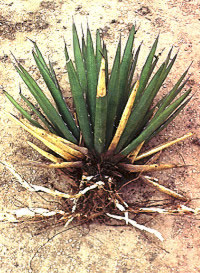
Fibers from the spikey leaves
of desert plants such as lechuguilla (shown) and
yucca can be quickly stripped and made into cording
for rope or knotted into carrying bags. Photo
from ANRA-NPS Archives at TARL.
|
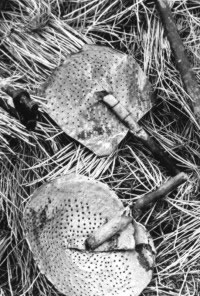
Two well-used wax skimmers
handmade from tin cans. Photo by Curtis Tunnell.
|
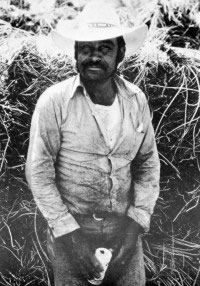
A hard-working cerero enjoying
a small "mordida" of cold beer offered as a small
token of gratitude by archeologists who interviewed
them and photographed their work. Photo by Curtis
Tunnell.
|
|
|
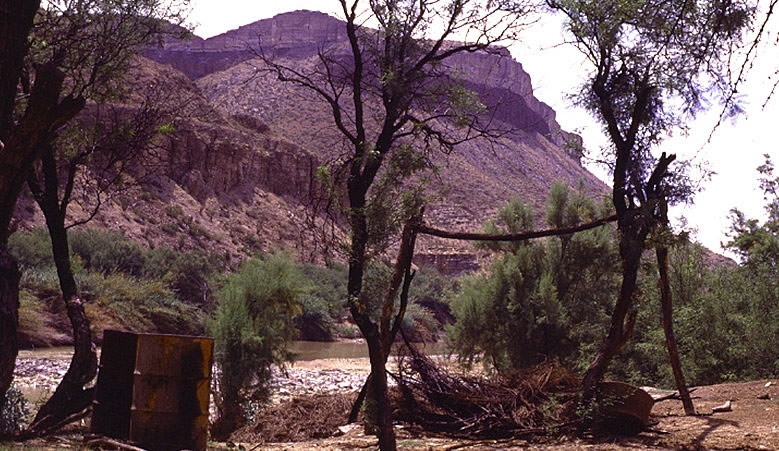
Abandoned wax camps are familiar sites
along the Rio Grande. Many are reused after the candelilla
stands have grown back in the area. Note the steel wax-boiling
vat (overturned, at left) and the sagging remains of a ramada,
or shelter, on right. This camp is in Santa Elena Canyon.
Photo by JoAnn Pospisil.
|

A worker continues to boil
wax despite Rio Grande flood waters within inches
of entering the firebox. The processing stations
are typically located immediately beside the river
to have easy access to water; camp and sleeping
areas are set further back. Photo by Raymond Skiles,
Boquillas Canyon, 2002. Click to see full image.
|
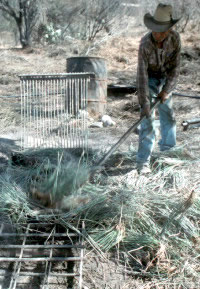
A seasoned wax maker loads a vat with weed. In some camps, there is often an older, master wax maker who is nominally in charge of operations. Photo by Raymond Skiles. |
| |
| |
| |
|
Location and Features
Rarely, a wax operation may be set up
sufficiently near a settlement that the men can commute
from their homes to the production area, but most such
locations were exhausted long ago. By far the most common
pattern is for several men, three or four to eight or
ten, to take their vats and donkeys into a remote can-yon
area where candelilla is abundant and establish a camp,
which they may use continuously for months and intermittently
for years.
A few camps may be found near springs,
tinajas (potholes), or windmills, but the majority,
even those in out-of-the-way places in the canyons,
are located near the river. The camps occur on both
sides of the Rio Grande and seem to be situated according
to convenience with no consideration of the international
boundary. The vats usually are placed immediately beside
the river on the first terrace, about 6 or 7 feet above
normal river flow and 10 to 12 feet back from the terrace
edge. Living areas may be from 30 to 100 feet farther
back on the same level but are more often on the edge
of the second silt terrace. The area of the camps varies
from about a quarter acre to as much as two acres, with
most of the area devoted to stockpiles of candelilla
awaiting processing and spent weed drying for fuel.
The most prominent features in the camps
include vats and firepits, deeply worn trails, piles
of ashes, sleeping shelters, candelilla stock-piles,
yerba seca (cooked candelilla) piles, sun-shades
or ramadas of various types, brush fences, and
burned areas in brush and cane along the river. The
most obvious activity area in a camp is the area where
the weed is processed. The living area where the men
sleep and cook is also clearly delimited in most camps.
Occasionally there may be an area where the burros are
maintained. Trash seems to be scattered randomly about
rather than deposited in a systematic way.
Work Organization
There are various types of organization
in the wax camps. Some camps are composed of several
individuals who gather weed for themselves and take
a "turn" at the wax pit when they have stockpiled
sufficient candelilla. Other camps, especially those
on ejidos, consist of a group of men working
in common and sharing in the profits of the operation.
A few camps belong to one man, a rancher or jefe,
who pays wages or a commission on the wax to the workers.
Adams said there were from five to seven camps producing
wax on his ranch in 1980, and these are operated according
to a modified commission plan. He has a foreman who
buys wax from the camps and then sells it to Adams,
and the man makes about 10 cents per pound for the transaction,
Adams finds it necessary to buy the wax by the sack
even though it is produced on his land, because if he
paid the candelilleros to produce it, he would not get
as much for his money. Buying wax produced from his
own weed costs the same per pound as wax brought from
Mexico.
Job assignments in the camps vary. In
some, men seem to have particular jobs—stoking
the fire, carrying water, skimming the vat, breaking
wax blocks, bagging cerote—and the jobs have different
status within the group. In other camps chaos seems
to reign, with different men doing different jobs at
different times and some obviously doing more than their
fair share. There often is one older man, the master
wax maker, who is nominally in charge.
Shelters
|
|
The most prominent features in the camps include
vats and firepits, deeply worn trails, piles of
ashes, sleeping shelters, candelilla stock-piles,
yerba seca (cooked candelilla) piles, sun-shades
of various types, brush fences, and burned areas
in brush and cane along the river.
|
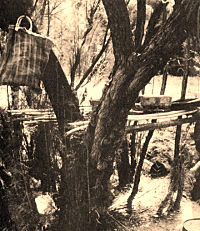
A camp beneath the trees with a makeshift storage platform. Note the plastic carrying bag hanging in the tree at left, a more common sight now in wax camps. Photo by Curtis Tunnell. |
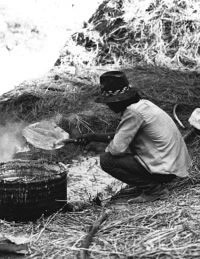
Squatting in front of the boiling vat, a worker skims waxy foam off the top. Some camps have assigned tasks for workers, and the jobs have a different status within the group. Photo by Curtis Tunnell. |
| |
| |
|
|
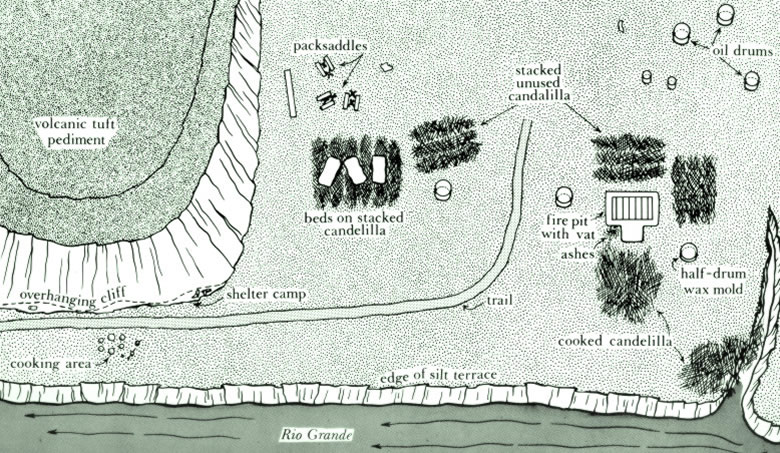
Wax camp above Mariscal Canyon. Note cerrero's beds "under the stars" on stacks of candelilla at center and shelters in overhanging cliffs at left. Drawing by Sharon Roos, THC. |
|
In pleasant weather the wax makers usually
prepare meals on open hearths and sleep on top
of candelilla piles under star-filled skies.
|

A small cavity in a limestone
cliff has been turned into a compact shelter for
a wax maker. Front view (A) and overhead view
(B). Drawing by Sharon Roos, THC.
|
|
In pleasant weather the wax makers usually
prepare meals on open hearths and sleep on top of candelilla
piles under star-filled skies. However, shelters are
always provided in the camps for those nights when rain
storms rumble through the canyons or cold north winds
bring chill and frost.
Rockshelters are the quickest, easiest,
and most durable type of shelter available in the desert,
and the cereros never miss an opportunity to use them.
In some areas, small cavities and crevices in limestone
serve as individual living units, which may be furnished
with candelilla and burlap-bag beds, pegs, and a rat
wire for protection of food. These shelters serve well
in the most inclement weather. More commonly, overhanging
cliffs provide partial shelter for camps and storage
of possessions.
Simple to fabricate and reasonably effective
shelters are prepared under convenient mesquite trees.
Branches are chopped from the underside of two or three
large overhanging branches, and the shelters are thoroughly
thatched with candelilla and cardboard when available.
A candelilla bed and cobble-lined hearth complete the
living unit, which is effective in a rain but gives
little shelter from cold wind.
|
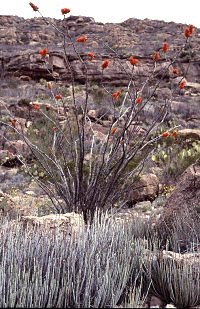
An ocotillo plant in fiery
bloom looms over a stand of candelilla. Limbs
of the ocotillo are used as poles in the waxmakers'
camp shelters. Photo by JoAnn Pospisil.
|
|
|

A wax camp where workers constructed mesquite shelters in Boquillas Canyon. Note fence made of thorn bushes at left, encircling the processing area. Drawing by Sharon Roos, THC. |
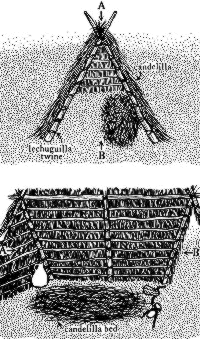
A "house" made of plants. This
typical wax maker's shelter, shaped like a pup
tent, is made of poles from the desert ocotillo
plant, is tied with cording of lechuguilla fibers,
and is thatched with candelilla. Front view and
side view. Drawing by Sharon Roos, THC.
|

A rusted steel wax vat is lodged
in the sand, after having been washed away by
a flood. River camps always run the risk of losing
vats during floods. Photo by Raymond Skiles.
|
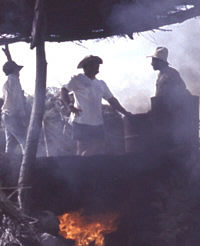
Waiting for the wax to boil.
When not actively engaged in processing, waxmakers
spend much of their time standing or squatting.
Photo by JoAnn Pospisil.
|
|
At sites where high silt terraces face
the wax-producing ground, substantial dugout shelters
may be prepared. These have well-smoothed walls with
niches and pegs for storage and unlimited potential
for graffiti. The roofs are made with wooden support
poles and vigas thatched with thick layers of candelilla
interspersed with cardboard and rags. Candelilla beds
and cobble-lined hearths are on the floor. These dugouts
provide adequate shelter for most weather and may survive
for years in a desert environment.
Another type of fabricated shelter is
about the size and shape of a pup tent. This type is
made from a framework of wooden and ocotillo poles tied
together with lechuguilla fibers and thatched with candelilla.
A candelilla bed and plastic water bottle constitute
the furnishings. Hearths are not compatible with these
shelters, which provide only moderate protection from
rain and cold.
Wax Vats
Like the shelters improvised by the workers,
the equipment used in making wax varies from camp to
camp and according to circumstance. A large wax vat
(called a paila or occasionally caldera
by the cereros) may be made from half a steel boiler
cut lengthwise or fabricated from sheet steel in a welding
shop in one of the larger cities. In some camps the
vats are provided by the wax refiner and do not belong
to the cereros who use them. The vats vary in size and
shape but may be about 6 feet long, 3 feet wide, and
3 feet in depth. A heavy steel grate is attached at
either end by loop hinges and, after much stomping to
submerge the weed, a lever clamps the grate at the center
to hold the load in place until the wax is boiled off.
The vats and grates can be used for years, although
they frequently need patching or small repairs.
A small wax vat made from half an oil
drum cut lengthwise was seen tied between two wooden
poles and carried by two burros. It was designed for
easy transport into a remote niche where a tinaja of
rainwater would support a brief rendering operation.
A grate of hardwood sticks was used to submerge the
weed in this small vat.
Modern Conveniences
Certain categories of things, which we
who are accustomed to a more affluent existence might
expect to find in wax camps, have never been observed
there. Trucks, although used to haul weed to some of
the early factories, are not in evidence. We have never
seen a motor vehicle, or remains of one, in camps along
the river. Devices for marking the passage of time such
as radios, calendars, clocks, and watches have not been
recorded there. Basic tools such as axes, hammers, and
saws are apparently replaced by machetes and hammerstones.
Lighting devices such as flashlights, candles, lanterns,
and lamps have never been seen in the camps; moonlight
and a campfire suffice at night. The convenience of
boats, mattresses, and even gloves cannot be afforded
by the cereros; nor can eye glasses, finger rings, dishes,
and flatware. For those who live standing up and working
or sleeping on the ground, there is no need for chairs
and tables. Common domestic animals such as dogs, cats,
and chickens have not been observed. The sharp eye of
a master wax maker judges the weight of bags of wax
in lieu of scales. Even such inexpensive conveniences
as books, paper, pencils, and soap are apparently beyond
the means of or simply not desired by cereros.
|
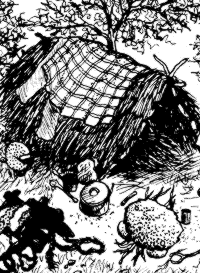
Fabric or blankets are often
draped over the shelters to provide another layer
of insulation. Drawing by Sharon Roos, THC.
|
|
For those who live standing up and working
or sleeping on the ground, there is no need for
chairs and tables.
|
|
|
|